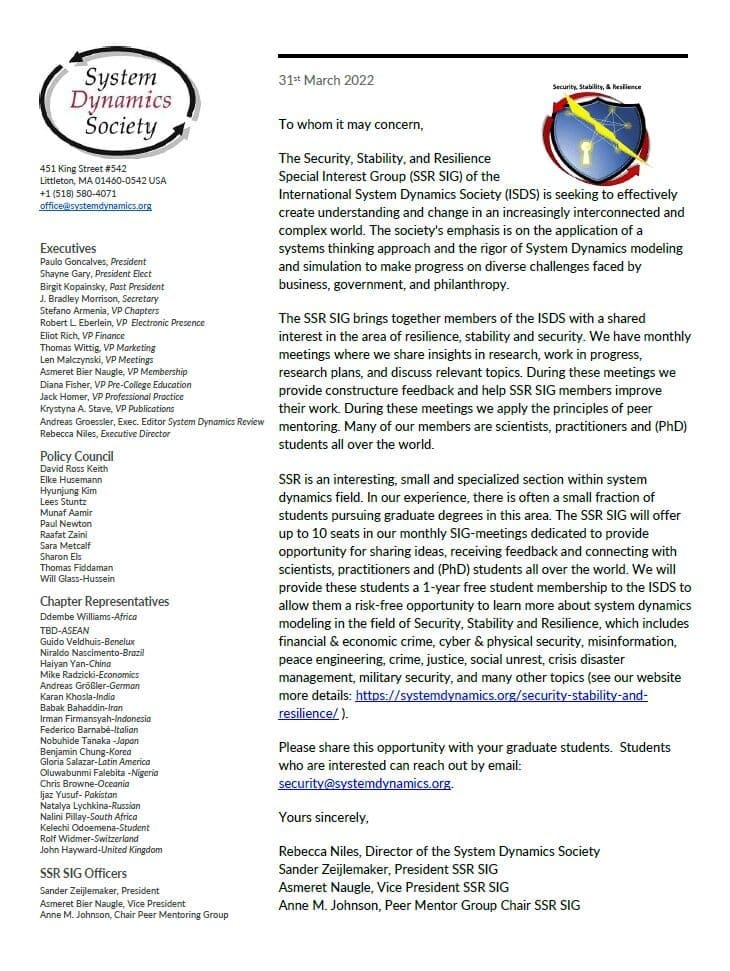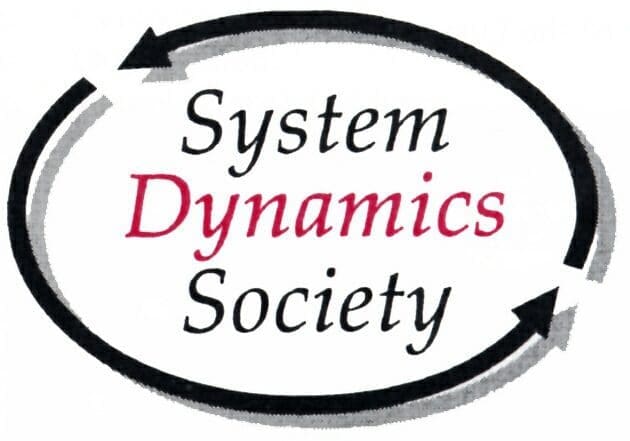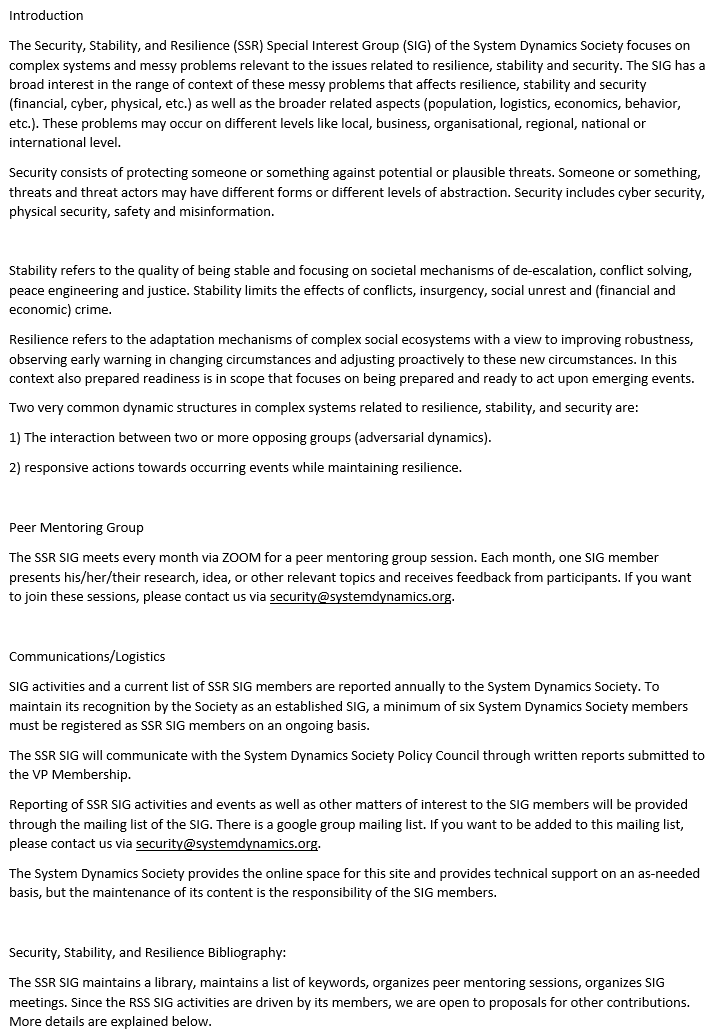Security, Stability and Resilience Special Interest Group (SIG)
Join us to learn different modeling techniques, diverse applications of system dynamics for various security, stability and resilience topics, and policy tools!
Click on the Engine and edit your profile. Not a Society member? Create a free account to join the SIG.
UPCOMING
SIG EVENTS
SIG RESOURCES
Access past SIG meetings. Watch SIG youtube recordings.
Explore SSR-related models. Add models.
SSR courses using System Dynamics. Add courses.

SSR SIG keywords
|
Security |
Security consists of protecting someone or something against potential or plausible threats. Someone or something, threats and threat actors may have different forms or different levels of abstraction. Security includes cyber security, physical security, safety and misinformation. |
|
National security |
National security is the security and defense of a nation-state, including its citizens, economy, and institutions, which is regarded as a duty of government. (source: Wikipedia). |
|
Physical security |
Physical security describes security measures that are designed to deny unauthorized access to facilities, equipment, and resources and to protect personnel and property from damage or harm. Physical security includes safety. |
|
Cyber security |
Cyber security refers to the body of technologies, processes, and practices designed to protect networks, devices, programs, systems, and data from attack, damage, or unauthorized access. It also allows unfettered trusted use by its owner. |
|
Misinformation |
Misinformation is false, inaccurate, incomplete, incomplete, and/or not in time misleading information that is deliberately communicated regardless of an intention to deceive. Misinformation includes fake news and disinformation. |
|
Stability |
Stability refers to the quality of being stable and focusing on societal mechanisms of de-escalation, conflict solving, peace engineering and justice. Stability limits the effects of conflicts, insurgency, social unrest and (financial and economic) crime. |
|
Peace |
A state of tranquility or quiet: such as (1) freedom from civil disturbance (2) a state of security or order within a community provided for by law or custom, (3) a state or period of mutual concord between governments, or (4) a pact or agreement to end hostilities between those who have been at war or in a state of enmity. |
|
War |
A state of armed conflict between (1) different countries, (2) different groups within a country, or (3) non-state actors between countries, where there is a high level of casualties. A war is usually the result of an escalated armed conflict. |
|
Failed state |
A state whose political or economic system has become so weak that its government is no longer in control. |
|
Armed conflict |
A state of armed conflict between (1) different countries, (2) different groups within a country, or (3) non-state actors between countries, where there is a low level of casualties. An unresolved armed conflict may end in a war. |
|
Unarmed Conflict |
A state of unarmed conflict between (1) different countries, (2) different groups within a country, or (3) non-state actors between countries, where parties have a serious disagreement or argument; typically a protracted one. An unresolved unarmed conflict may end in an armed conflict. |
|
Terrorism |
The use of violence and intimidation, especially against civilians ( in the pursuit of political aims). |
|
Immigration |
The action of coming to live permanently in a foreign country. |
|
justice |
The maintenance of what is perceived as just especially by the impartial adjustment of conflicting claims or the assignment of merited rewards or punishments. A good justice system limits the growth and size of (potential) conflicts. |
|
Mass shootings |
A mass shooting is an incident involving multiple victims of gun violence; with the intent of the shooter(s) to kill as many people as possible. |
|
Crime |
An action or omission which constitutes an offense and is punishable by law. |
|
Financial Crime |
Financial crime is a crime committed against property, involving the unlawful conversion of the ownership of property (belonging to one person) to one’s own personal use and benefit. |
|
Resilience |
Resilience refers to the adaptation mechanisms of complex social ecosystems with a view to improving robustness, observing early warning in changing circumstances and adjusting proactively to these new circumstances. In this context also prepared readiness is in scope that focuses on being prepared and ready to act upon emerging events. |
|
Peace engineering |
Peace engineering is a multidisciplinary systemically approach that tackles issues like cyber warfare, climate change, poverty, and other conditions that come in the way of long-term stability and peace. |
|
Emergency planning |
Emergency planning is a multidisciplinary and systematic approach to minimize the effects of incidents or crises. The main objective of emergency planning is to reduce injuries, protect the community, maintain business continuity and minimize damage. |
|
Prepared readiness |
This is a stage of being prepared: readiness. It refers to the procession of sufficient armed forces, industry resources, societal capabilities, or other reserves especially as a deterrent to enemy attack (military) or means that absorb the effect of a disaster or crisis (non-military). |
|
Crisis management |
Crisis management is the systematic approach to avoid a crisis or when a crisis occurs contain it and minimize the effects of |
SECURITY, STABILITY AND RESILIENCE FRIENDLY
Friendly journals to publish your System Dynamics, SSR-based work. Check out “Publisher” in our bibliography to find further publishing options.
The SSR-SIG supports and promotes System Dynamics threads in a number of conference and other events.
At the International System Dynamics Conference, the Security Threat is related to the Security, Stability and Resilience (RSSR).For the 2022 International System Dynamics Conference, Saeed P. Langarudi and Ignacio Martinez-Moyano are the Thread Chairs.
referral
The Society offers a referral service to match members offering services with those looking to learn or apply systems thinking or System Dynamics. Fill out the form to show your availability.
Looking for a Systems Consultant? Fill out this form and we will follow up with a call and, soon enough, the right person for the job.
Learn more about our Training Services and Consulting Services available to meet your needs.
SIG BLOG
Learn more about the latest developments in the security, stability and resilience field and how System Dynamics and systems thinking is making an impact.
SIG GOALS & HISTORY
The Security, Stability, and Resilience (SSR) Special Interest Group (SIG) of the System Dynamics Society focuses on complex systems and messy problems relevant to the issues related to resilience, stability and security. The SIG has a broad interest in the range of context of these messy problems that affects resilience, stability and security (financial, cyber, physical, etc.) as well as the broader related aspects (population, logistics, economics, behavior, etc.). These problems may occur on different levels like local, business, organisational, regional, national or international level.
Two very common dynamic structures in complex systems related to resilience, stability, and security are:
1) The interaction between two or more opposing groups (adversarial dynamics).
2) responsive actions towards occurring events while maintaining resilience.
SSR SIG library
The SSR SIG maintains a library of information for its members.
a) Knowledge base for SSR SIG members
The library provides access to publicly available related to resilience, stability, and security literature (papers, publications, etc.), and lists open data sources, potentially relevant journals for publication, and conferences of interest to the SIG. This library is accessible via this link:https://airtable.com/shrpICm6HzRMV4U8o
Check out the SSR SIG charter to learn more about the SIG.

Sander Zeijlemaker
President

Asmeret Naugle
Vice-President

Anne M Johnson
Peer Mentoring Group Chair










